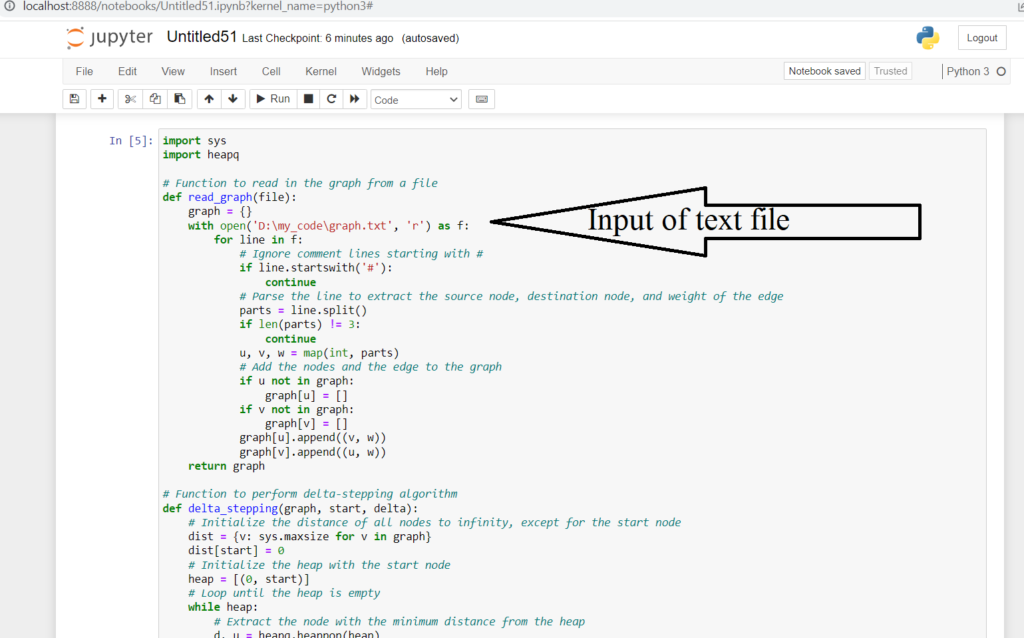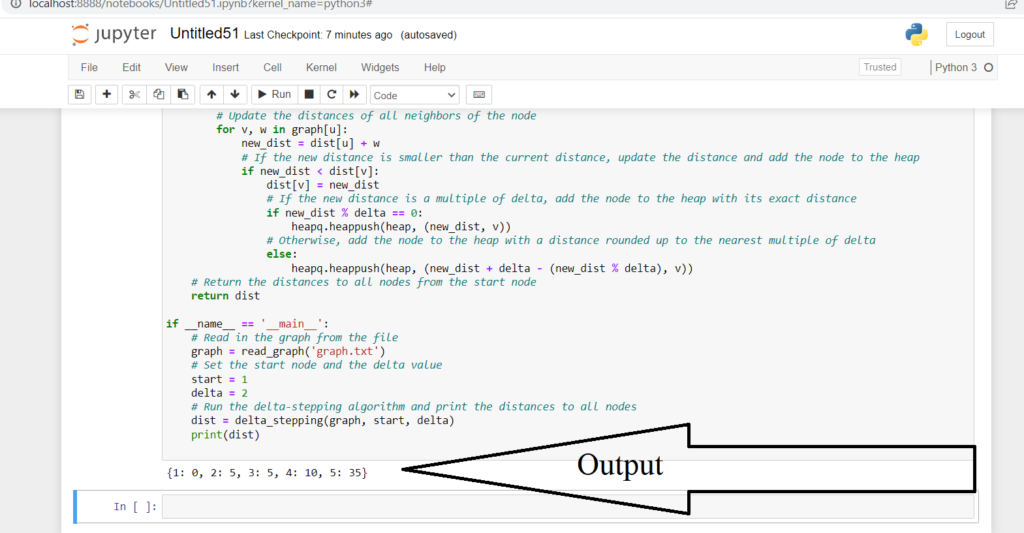Delta-Stepping Algorithm
Delta-stepping is a parallel algorithm for finding the shortest path in a weighted graph. It was first introduced by David Johnson and Brian Sandberg in 1989.
The algorithm is similar to Dijkstra’s algorithm, but it works by processing the graph in “buckets” of nodes, where each bucket contains nodes whose shortest distance from the source node is within a certain range (known as the “delta”). The algorithm starts with a delta of 0 and gradually increases the delta until all nodes have been processed.
At each iteration of the algorithm, the nodes in the current bucket are processed in parallel. For each node, the algorithm updates the distance to all of its neighbors, and if the new distance is within the range of the next bucket, the neighbor is added to the next bucket.
Delta-stepping has several advantages over Dijkstra’s algorithm, particularly for large-scale graphs. Because it processes nodes in parallel, it can be more efficient on multi-core processors and distributed systems. Additionally, by processing nodes in buckets, it can reduce the number of nodes that need to be processed at each iteration, leading to faster convergence.
However, delta-stepping has some limitations as well. In particular, it is more complex to implement than Dijkstra’s algorithm, and it may not be as effective on small graphs or graphs with highly variable edge weights.
Algorithm:
- Initialize the distance of all nodes to infinity, except for the source node, which has distance 0.
- Set the delta to a small value, such as 1 or the square root of the number of nodes in the graph.
- Create a list of “buckets”, where each bucket contains nodes whose distance from the source node is within the range [deltak, delta(k+1)] for some integer k.
- Add the source node to the first bucket (i.e., the bucket for k=0).
- While there are non-empty buckets:
a. Take the first non-empty bucket.
b. Process the nodes in the bucket in parallel:
i. For each node, consider all its neighbors and compute the distance to each neighbor as the sum of the current distance to the node and the weight of the edge to the neighbor.
ii. For each neighbor, if its new distance is less than the current distance, update its distance and add it to the corresponding bucket.
c. If the current bucket is empty and there are remaining non-empty buckets, increase the delta and reassign the nodes to new buckets based on their updated distances.
- When all buckets are empty, the algorithm terminates and the distances to all nodes from the source node are computed.
Note:
The choice of delta can affect the performance of the algorithm. A smaller delta can lead to more buckets and finer-grained parallelism, but may increase the overhead of managing the buckets. A larger delta can reduce the number of buckets and simplify the algorithm, but may reduce the parallelism and increase the convergence time. Therefore, the delta value should be chosen based on the characteristics of the graph and the computing environment.
Implementation of the delta-stepping algorithm in Python:
import sys
import heapq
# Function to read in the graph from a file
def read_graph(file):
graph = {}
with open(file, 'r') as f:
for line in f:
# Ignore comment lines starting with #
if line.startswith('#'):
continue
# Parse the line to extract the source node, destination node, and weight of the edge
parts = line.split()
if len(parts) != 3:
continue
u, v, w = map(int, parts)
# Add the nodes and the edge to the graph
if u not in graph:
graph[u] = []
if v not in graph:
graph[v] = []
graph[u].append((v, w))
graph[v].append((u, w))
return graph
# Function to perform delta-stepping algorithm
def delta_stepping(graph, start, delta):
# Initialize the distance of all nodes to infinity, except for the start node
dist = {v: sys.maxsize for v in graph}
dist[start] = 0
# Initialize the heap with the start node
heap = [(0, start)]
# Loop until the heap is empty
while heap:
# Extract the node with the minimum distance from the heap
d, u = heapq.heappop(heap)
# If the distance to this node has already been updated, skip it
if d > dist[u]:
continue
# Update the distances of all neighbors of the node
for v, w in graph[u]:
new_dist = dist[u] + w
# If the new distance is smaller than the current distance, update the distance and add the node to the heap
if new_dist < dist[v]:
dist[v] = new_dist
# If the new distance is a multiple of delta, add the node to the heap with its exact distance
if new_dist % delta == 0:
heapq.heappush(heap, (new_dist, v))
# Otherwise, add the node to the heap with a distance rounded up to the nearest multiple of delta
else:
heapq.heappush(heap, (new_dist + delta - (new_dist % delta), v))
# Return the distances to all nodes from the start node
return dist
if __name__ == '__main__':
# Read in the graph from the file
graph = read_graph('graph.txt')
# Set the start node and the delta value
start = 1
delta = 2
# Run the delta-stepping algorithm and print the distances to all nodes
dist = delta_stepping(graph, start, delta)
print(dist)The sample “graph.txt” file that corresponds to the input provided :
# Sample graph file
# Each line contains three integers representing an edge (u, v) with weight w
# Nodes are numbered starting from 1
1 2 5
1 3 5
1 4 10
2 5 5
3 5 10
4 5 25

